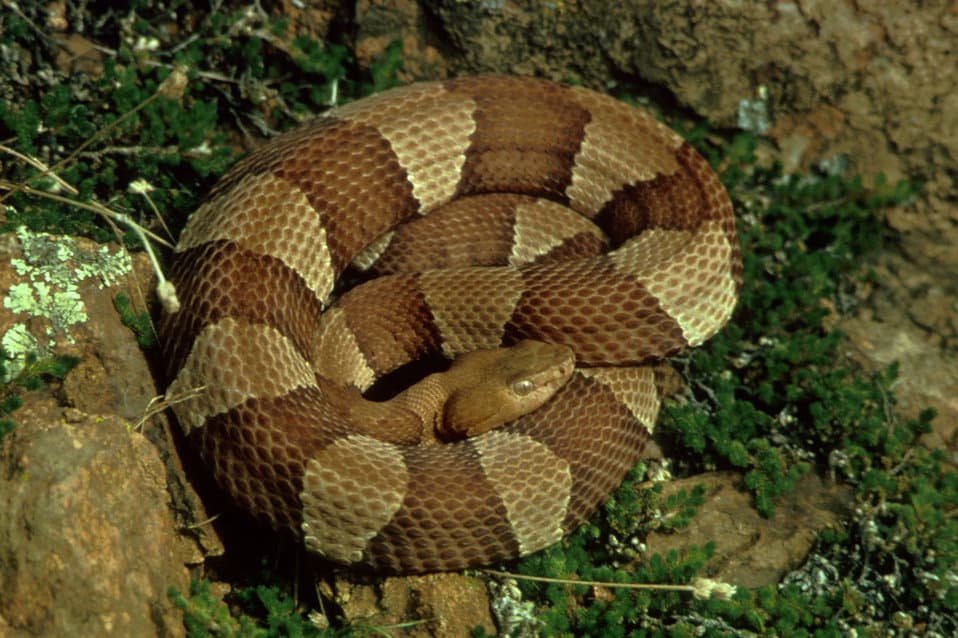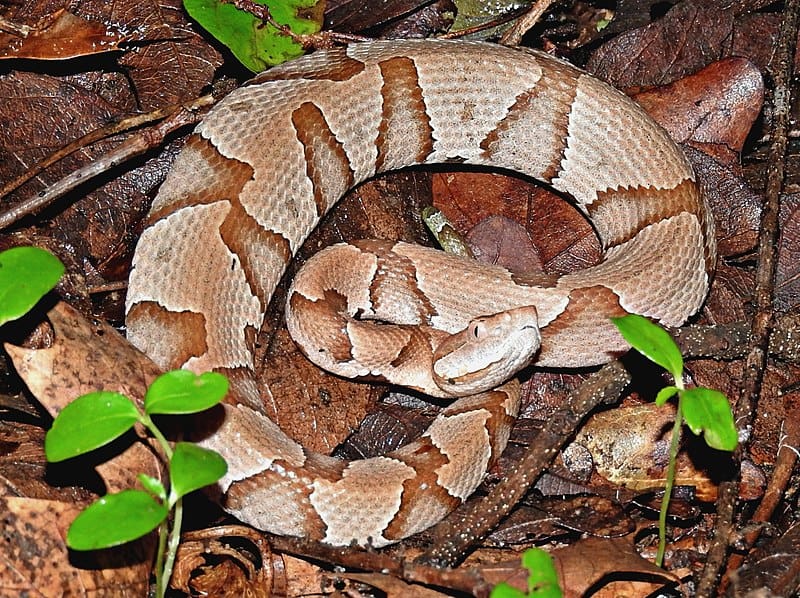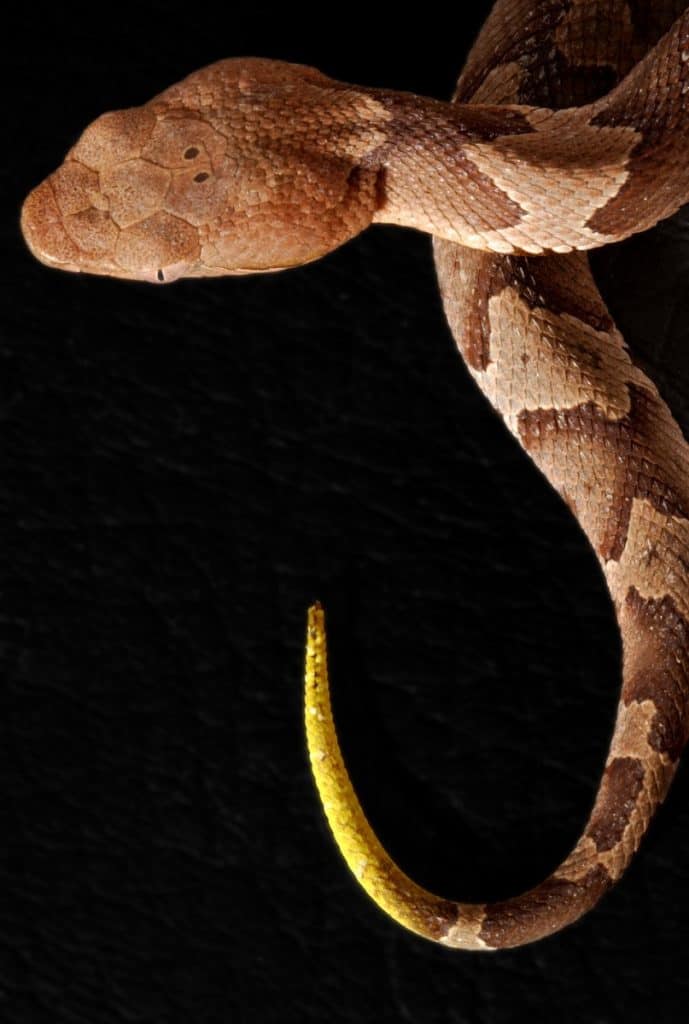The copperhead is one of the more interesting venomous snakes in the United States, and one that comes with a lot of questions. One of the major questions is just how dangerous are they? And unfortunately, that is a rather complicated question.
Copperheads are quite dangerous as they are responsible for the far majority of venomous snake bites in the United States. They are among the most aggressive venomous snakes, instinctively striking & biting versus running away. Their incredible camouflage can make them nearly impossible to see until you’re already bitten.

You might hear that copperheads have a less dangerous venom than other venomous snakes. This is true. BUT that’s no reason to say that copperheads aren’t dangerous.
While it’s technically correct that a copperhead snake’s venom is among the least potent, it’s still very dangerous to people and can easily kill children, elderly, immune compromised, those who are allergic, or even fully healthy adults if let untreated.
There’s no question that copperheads are extremely dangerous to children, the elderly, and pets. They are capable of killing fully healthy adults, as well.
There are many cases on record of adults recovering without treatment (some with permanent pain or injuries, some without), but this is FOOLISH because a copperhead bite can absolutely be fatal.
No matter what your age or health, you should ALWAYS seek medical care after being bitten, or even suspect being bitten, by a venomous snake. Just don’t take the chance!
While it can be “technically” true that a copperhead bite is less dangerous on average than a bite from a rattlesnake, that’s like saying getting stabbed by a 6 inch knife is less dangerous than a 12 inch knife.
Still not a good situation.
So what do you need to know about the practical danger of a copperhead bite? Read on to find out!
Why Are Copperheads So Feared?
The easy answer to this is because many people with an up-close experience ended up getting bit. Or just avoiding it.
The overwhelming majority of snakes are flee first and fight as a last resort. Copperheads are one of the few snake types in North America that are the opposite. Their way of defending themselves is to bite, envenomate, and then run.

Or bite multiple times from an ambush position, then run.
Either way, it’s not good news for the person.
This is one of the easiest to see copperhead pictures you’ll run into. The sheer number of “Where’s the copperhead?” pictures that come up on Google is insane.
And even when you’re an experienced woodsman who knows how to look for the signs…these can be very hard snakes to see.
Sometimes impossible until the bite happens.
Because of that even with a less toxic bite a copperhead is incredibly dangerous.
When the snake bites first and flees later, you need to treat it seriously. Especially with snakes like the copperhead that are so good at blending in to their surroundings.
The rough estimates are that just under 10,000 people are treated for venomous snake bites in an average year in the United States. Copperheads are often responsible for up to 6,500-7,000 of them.
That’s why they’re feared.
How Dangerous Are Baby Copperheads?
There are a lot of wives’ tails about baby copperhead bites being more dangerous because they “Can’t control the flow of venom.” This is not factually true.
Bigger snakes can inject so much more venom that even a partial bite is far more dangerous than what he smallest of copperheads can produce.
While “dry bites” are a bit more common with adult copperheads than younger ones, that doesn’t make the younger snakes more dangerous. Young copperheads dry bite, as well, and the difference in volume of venom matters a lot.

While you should do your best to avoid getting bitten by a copperhead in any situation, the good news is that as long as you get treatment chances are extremely good you’ll be fine.
Whether it’s an adult copperhead or a young copperhead. All of them are dangerous.
But the story that baby or young venomous copperhead snakes are more dangerous than fully grown adults just doesn’t hold true.
How Dangerous Are Copperheads to Dogs?
Copperheads are incredibly dangerous to dogs. In fact, many small dogs will find a copperhead bite possibly fatal. The instinct of a dog to fight back when attacked could also result in multiple bites, meaning if a dog might be able to survive one bite, a second or third will lead to too much venom.
If you see your dog bitten by a copperhead, you need to take that dog to a vet immediately. It’s possible that with fast proper treatment the damage can be minimized for the furry four-legged member of your family.
The good news?
When properly treated the death rate among dogs is less than 10%. If you have a very healthy, very big outdoor dog the odds are very good that he or she will survive a bite and might even be in relatively good spirits after a visit to the vet for treatment.
There are good veterinary treatments available, though. This post from a North Carolina vet in the heart of snake country gives a solid run through of what to do if your dog is bitten by a copperhead.
Protecting Yourself from Copperhead Bites
There are a few ways to protect yourself when it comes to going out and about in copperhead country.
Know When They Are Most Active
This can vary a bit from place to place, but shortly after copperheads give birth tends to be when you have the most active populations of copperheads.
Not only do you have the population explosion among baby copperheads but adults tend to be out and about around this time before settling back into normal patterns.
By knowing when copperheads in your specific area are most active you know when it’s a good time to take a stroll through the woods and then those times where maybe you should just wait.
Look At Protective Clothing
Your choices in clothing matter when it comes to keeping yourself protected. There are a few major options here, and depending on how often you head out into the woods in snake country, you may want more than one.
The best three options?
We’ve gone over how denim can minimize venom from a rattlesnake bite, and that same policy applies to other snakes. The thick material won’t straight up stop a bite from a big snake, but it can help to lessen the damage.
That makes denim jeans a good first option, but they’re not pure prevention.
However, it is the most non-intrusive option for non-hunters.
Snake gaiters are another great option, and these are designed to straight out block a snake bite. You have these on the lower legs with a thick boot and no bite is getting through any of that!
Snake proof boots are the final option. These are generally built as thick hunting boots that are appropriate for colder or wetter climates. These may or may not work comfortably depending on where you are and what season it is, but they are an option for dealing with copperhead snakes.
Our top choices are linked in the bullet point list up above. A little bit of prevention is better than a $10K+ hospital bill for a snake bite treatment.
You don’t need them, per se, but it’s a great bit of piece of mind.
Keep Very Open Eyes in the Woods
Many animals have some sort of color design or camo that helps them blend in. Copperheads are next level in that department.
Still, you need to keep your eyes open for any sign of yellow tails, movement through the leaves, or any giveaway that you might be closer to a copperhead than you care to be.
May I suggest a hiking stick? You never know when that might help save you from a very unfortunate option.
Are Copperheads Dangerous: The Verdict
The copperhead is a venomous snake that needs to be taken seriously. While its venom is less toxic than that from your normal rattlesnake or water moccasin, it’s still very dangerous and potentially harmful.
That makes the copperhead dangerous, and when you consider that other venomous snakes will generally prefer escape before attacking, the copperhead is the one viper native to the United States that does this.
Because of that you always need to be careful. Modern medicine is an amazing thing but if you can avoid the painful and potentially dangerous copperhead bite, that’s even better.
